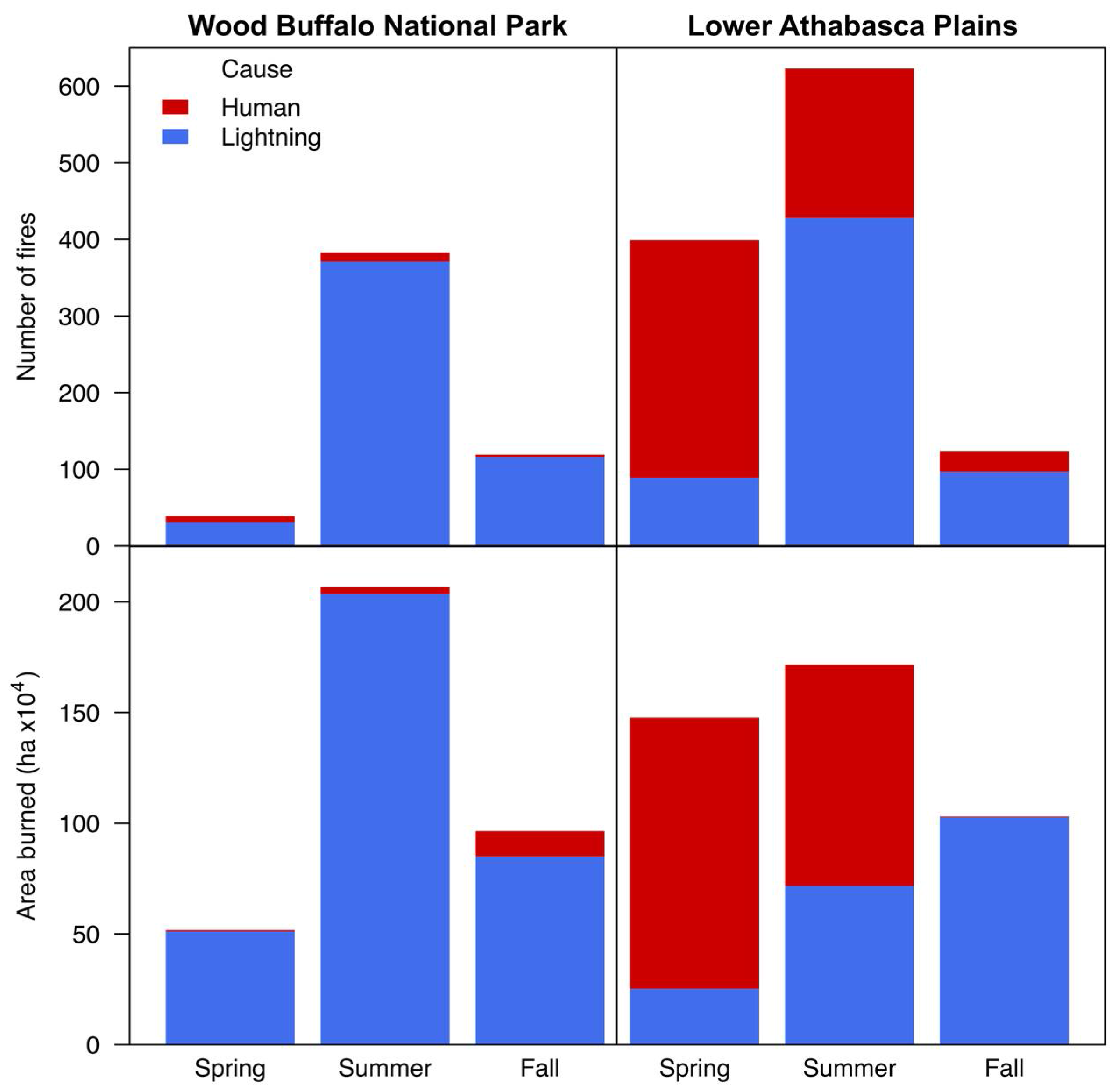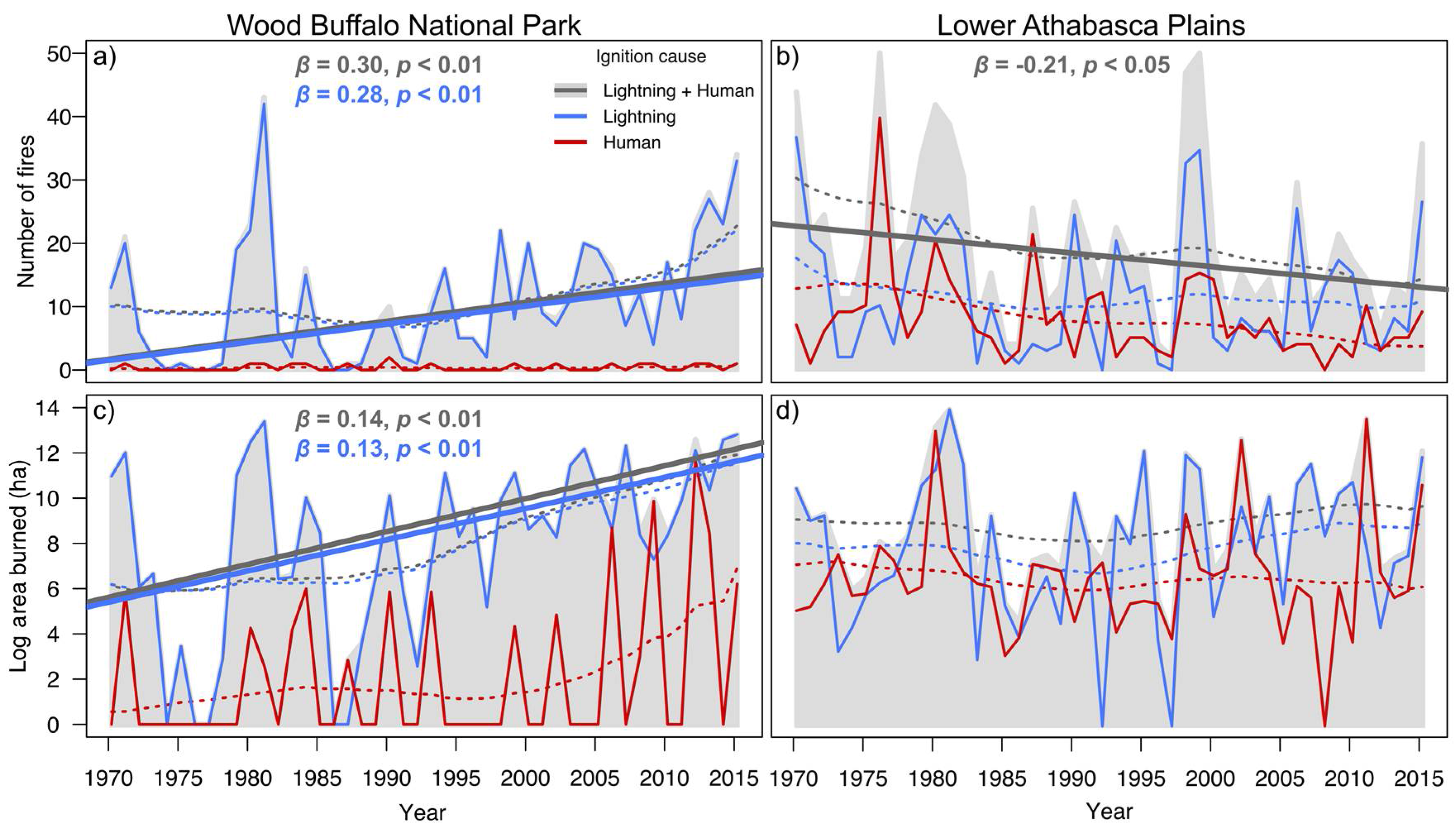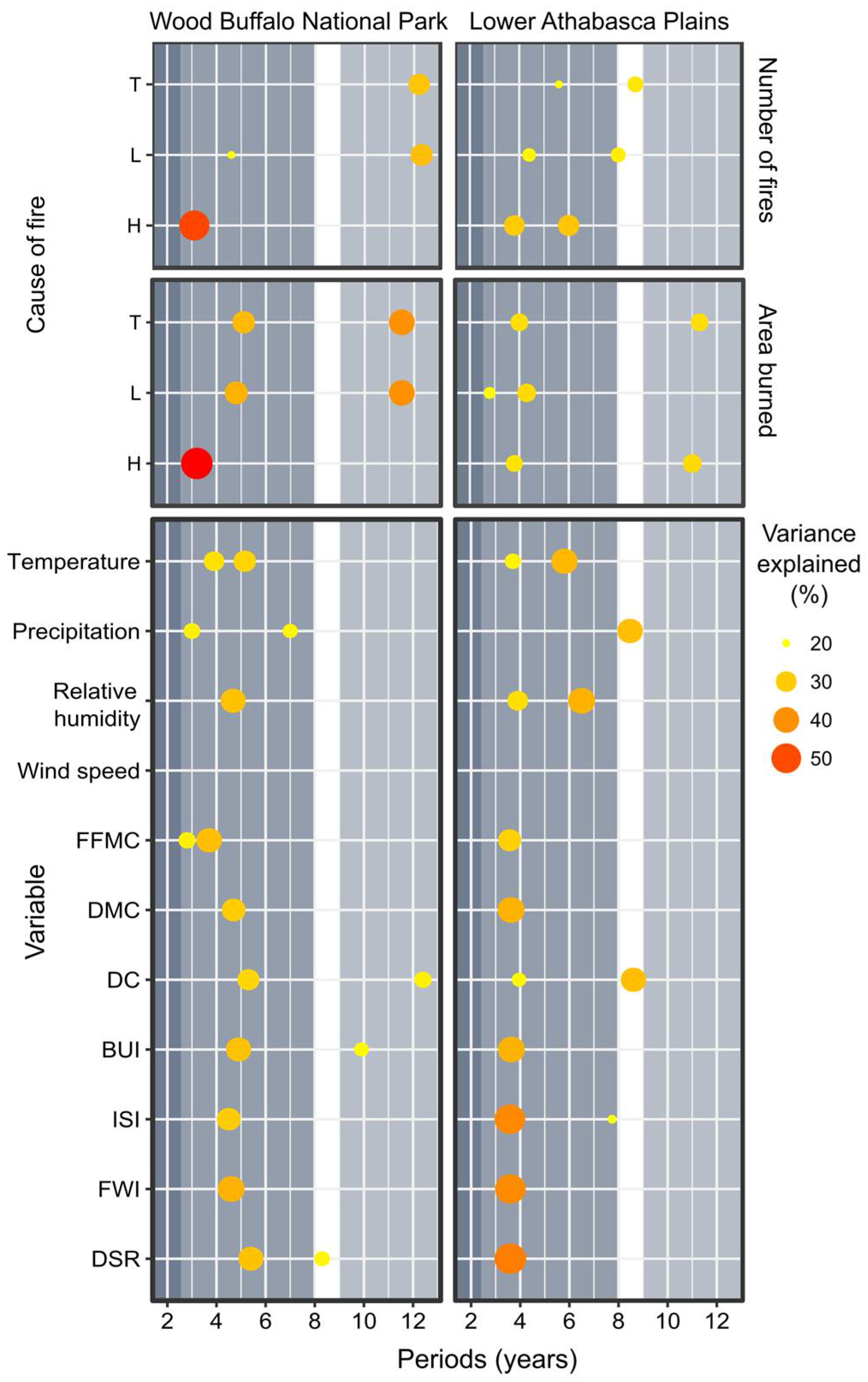1. Introduction
Wildfire is a critical phenomenon maintaining the ecological processes and integrity of the Canadian boreal forest [
1]. Although most fire regimes in Canada are characterized by infrequent, high-intensity, extensive fires occurring mostly between May and August, there is great variability in the components of the fire regime across spatial and temporal scales [
2]. Understanding the spatio-temporal patterns of fire occurrence and area burned is thus of foremost interest in Canada in ecological, social, and economic terms. Wildland fires burn on average between 1 to 3 million ha annually in Canada, affecting biological diversity [
3,
4], ecological services [
5,
6], and forest resources [
7], and require costly fire management strategies for infrastructure and community protection [
8,
9].
Fire activity, which is usually measured as the number of fires and the total area burned, is driven by weather, climate [
10,
11], vegetation type [
12,
13], topography, human activities [
8,
14,
15], and complex interactions among these factors. Globally, wildfire dynamics have been altered by human activities for millennia through people setting (accidental or deliberate) ignitions that add to the ones caused naturally by lightning, and by modifying the landscape through their activities, increasing access to wildlands, and by altering the arrangement, continuity, amount, structure, and distribution of fuels (i.e., flammable biomass). These changes, combined with climate change, have modified the components of the fire regime: severity, likelihood, seasonality, size, frequency, and intensity of fires [
13,
16,
17,
18,
19,
20].
Evidence suggests that fire suppression practices also have an important effect on the fire–weather relationship, potentially undermining the reliability of weather-based predictions. Current ignition rates in France, for example, are not as high as they were during the pre-suppression period, even under similar weather conditions [
21]. Fire regimes in Catalonia, Spain, cannot be efficiently predicted unless fire suppression activities, in addition to climatic variables, are taken into account [
22]. In the U.S. Rocky Mountains, alternating periods of fire–climate relationship strength were reported for the past century, suggesting that the interaction of climatic and non-climatic factors, such as fire suppression, is highly complex and needs to be assessed to improve our understanding of fire activity [
23].
Over the last century, fire management activities in the Canadian boreal forest have shaped fire activity through aggressive suppression efforts and preventive measures. However, fire management has not been uniform over space and time because deploying resources to prevent and attack fires involves balancing potential economic, social, and ecological impacts, which can sometimes be conflicting [
24,
25,
26,
27]. To better reflect regional priorities, most of Alberta’s forested land surface has been divided into ten Wildfire Management Areas [
28] that are managed by the provincial government. Fire management in Alberta has increased the containment (i.e., extinguishment before they reach 2 ha in size) of fires from 75% in 1998 to 93% in 2015 [
29]. Regardless of technological advances and preventive measures, large fire events still occur in Alberta. Such is the case of the Horse River fire in Fort McMurray, Alberta (spring 2016; 580,633 ha burned), which caused the evacuation of 80,000 people and was the costliest natural disaster in Canada, with an estimated damage worth of CAN
$10.9 billion [
30,
31]. In contrast, National Parks within Alberta are not included in the provincial Wildfire Management Areas because the administration falls under federal jurisdiction. In these parks, unlike the rest of forested Alberta, the ecological role of fires is favored and wildfires are only supressed when they pose a risk to surrounding inhabited areas and areas containing rare natural resources [
32].
Although it is well recognized that human influence can alter fire activity in the boreal forest, the magnitude and direction of recent changes remain largely undocumented. The main goal of this study is to assess how human influence has affected the fire regime of two contrasting areas in the Canadian boreal forest over the past few decades. To achieve this goal, we analyzed the changes in the number of fires and area burned (fire activity) over time and their relationships with climate in two contiguous regions of Alberta with contrasting human influence (fire management and human land use). First, to establish whether fire activity has changed in each region, we analyzed annual trends of the number of fires and area burned, from 1970 to 2015, and compared them while distinguishing natural from anthropogenic fires. Secondly, to determine if the fire–climate relationships remain coherent despite the dissimilar human influence, we compared these relationships between regions. Finally, to better understand the correlations between fire activity and climate, we characterized the cyclical patterns of the number of fires, area burned, and climate, and compared them between regions in terms of the duration of their periodicities.
3. Results
Fire activity from 1970 to 2015 has increased in WBNP in both the number of fires (
β = 0.30,
p < 0.01,
Figure 3a) and area burned (
β = 0.14,
p < 0.01,
Figure 3c), while in LAP, there is a statistically significant decrease in the number of fires (
β = −0.21,
p = 0.01,
Figure 3b), and no overall change in area burned (
β = 0.02,
p > 0.05;
Figure 3d). Lightning-caused fires were responsible for raising the number of fires in WBNP (
β = 0.28,
p < 0.05), whereas anthropogenic fires remained low (
β = 0,
p > 0.05) and their area burned unchanged (
β = 0,
p > 0.05;
Figure 3a,c). Fire activity in WBNP exhibited nonlinear trends, indicating that the increase was faster during the second half of the time period than the first half. Although the non-linear trends suggest a decline in the number of fires caused by lightning or humans in LAP, neither of them were statistically significant (
β = 0,
p > 0.05 and
β = −0.9,
p > 0.05 respectively), but their sum (L + H) was (
Figure 3b).
In general, a warming and drying climate trend was found over the 46 years studied in both WBNP and LAP, with faster changes in WBNP (
Table 3). Most of the fire-climate time series showed some change (linear trend) over the same period that would lead to an increased wildfire activity, but this is only observed in WBNP. In general, for both WBNP and LAP, we found a declining trend in PRECIP, RH, and WINS, and an increasing trend for FFMC, DMC, DC, and BUI. Only ISI did not change overall in any of the areas. Although we did not find a linear trend for temperature in LAP, the non-linear trend extracted by SSA does show an increase (
Figure A3), as well as for FWI and DSR in WBNP. The most drastic increase in both areas was observed in the Drought Code, which indicates moisture deficits in the deeper soil levels (
Table 3).
Cross-correlations of detrended time series between regions indicated a similar pattern of fire activity regardless of the differences in human influence. Lightning-caused fire time series correlations (for both number of fires and area burned) showed the highest coefficients, whereas human-caused fires showed the lowest (
Table 4).
Although the association of fire activity with fire climate was similar in both regions (we observed significant correlations with similar coefficient values for both the number of fires and area burned time series;
Table 5), we noted that: (1) mean annual temperature was only correlated with lightning-caused fires in WBNP and human-caused fires and area burned in LAP, (2) mean annual precipitation was associated with lightning-caused fire activity but not human-caused fires in both areas, (3) human-caused fires in WBNP do not have any association with fire-climate, and (4) lightning-caused fires only correlated with temperature and relative humidity in WBNP. We only found three one-year lagged correlations: between the number of human-caused fires in LAP with wind speed (
τ = −0.30,
p < 0.005), and area burned by lightning ignitions with precipitation in WBNP (
τ = −0.26,
p < 0.05) and temperature in LAP (
τ = 0.29,
p < 0.005).
Fire activity in WBNP was characterized by longer and more acute periodicities than the ones found in LAP. We observed that the number of fires and area burned by lightning in WBNP showed strong activity peaks every ~12 years, whereas in LAP, weaker oscillations (i.e., under eight years) were most frequent. Anthropogenic ignitions in both areas mostly displayed high frequency (short periods) oscillations (~3–6 years); however, area burned by humans also showed strong oscillations every ~11 years (
Figure 4).
Fire-climate oscillations were very similar between regions, with the strongest periodicities (i.e., higher variance explained) falling under the ENSO domain (2.5–8 years) and aligning with many of the periodicities of fire activity (between 3–6 years). Most of the strongest fire-climate periodicities were found at around four years. With the exception of DC (an index of drought involving precipitation and temperature) and BUI (calculated through DC and DMC), we did not detect strong long periodicities (over nine years) from the fire-climate time series (
Figure 4).
4. Discussion
Human activities have been continuously altering the dynamics of the boreal forest in Alberta over the past few decades, and have generated recognizable spatial and temporal patterns of wildfire activity. In the 1970–2015 period, we found increasing fire-conducive climatic trends in both study areas that were reflected in occurrence and area burned increases only in the region with the lowest human interference (WBNP), which agrees with findings reported across Canada [
57,
58,
59]. In contrast, we observed a dampening effect of fire activity in the region with the most human impact (LAP), resulting in a decline in the number of fires and no overall change (no trend) in the area burned. Previous studies also suggest that although area burned has increased due to the changing climate in the boreal forest, this is not necessarily the case in areas of higher human influence [
60,
61].
The main causes limiting the potential area burned under high human influence are: (1) the strong prevention and fire suppression policies, (2) improved accessibility, (3) the location of the human ignitions (i.e., closer to human infrastructures), and (4) land-use change. The first cause is a consequence of two of the objectives of fire suppression in Alberta: reducing the spread of fires before 10 AM of the following day and preventing them from attaining 2 ha in size [
28], which results in fewer escaped fires (i.e., defined here as fires ≥10 ha). In addition, the widespread road network facilitates access for fire-management activities to take place. Although human ignitions might increase over time, they also have a tendency to cluster in the wildland-urban interface (WUI; [
61,
62]), where fire detection and initial attack are more efficient, impeding their further growth in spite of fire-prone weather conditions. Finally, conversion of forested areas to agricultural, urban, and petrochemical mining land uses has altered the vegetation’s structure and composition. These changes, in turn, have impacted the burn rates and ignition likelihood, and the increased fragmentation has reduced vegetation continuity, countering potential area burned [
15,
62,
63,
64,
65,
66,
67].
Wildfire suppression practices, in conjunction with other human-induced changes, have the potential to not just slow down, but also to reverse trends in fire activity; hence, non-climatic factors have the potential to alter fire-climate relationships. Such cases have been reported in France, where recent fire activity stopped tracking climatic trends and decreased along with major changes in fire suppression policy [
21,
68], and in South Africa, where land-use changes mediated the relationship between climate and area burned [
69].
Unlike trends, overall annual fluctuation patterns of wildfire activity exhibited some similarities between regions, regardless of the level of human influence. This is because climate and lightning still persist as dominant factors regulating the totality of fire activity in the boreal forest [
70,
71,
72]. We further support this observation, given that wildfire activity was similarly related to climate in both regions. In general, peaks of fire activity tracked a drier and warmer climate in both areas. We also found that temperature and relative humidity did not correlate to the number of lightning-caused fires in LAP, whereas they did in WBNP, suggesting that non-climatic factors (i.e., fire management, land-use change, road density) might have interfered with those relationships [
21,
73].
Anthropogenic fire activity is associated with the same climatic variables as lightning-caused fire activity, with only very few exceptions. Most notably, we observed a lack of association between anthropogenic fires and precipitation that might indicate that more of these fires may occur in years with higher soil moisture conditions than lightning-caused fires. This observation has also been reported before in the U.S. [
74], where the authors concluded that anthropogenic ignitions can occur in a broader range of moisture environments than lightning-caused fires, thereby resulting in a wider wildfire “niche”. In addition, the shift of the peak of anthropogenic fire activity from the summer to the spring, accompanied by a longer fire season length [
20,
74,
75,
76], might have caused anthropogenic and lightning fires associated with different climatic conditions within the year. This means that even if precipitation was higher overall during the year, the actual precipitation events might have been clustered to only the season where they could limit lightning-caused fires (summer), but not anthropogenic fires (spring).
We found periodicities that suggest a match with different teleconnections’ oscillatory patterns. Large-scale climatic patterns (teleconnections) and their interactions influence weather and local climate, and consequently, fire activity in Canada [
77,
78]. Wildfire cycles under higher human influence (LAP), as well as most fire-climate periodicities, were predominantly characterized by shorter periods (<8 years) compared to longer periods under low human influence (WBNP; >9 years). The short periodicities of fire activity under high human influence suggest a higher susceptibility to Quasi-biennial and el Niño Southern Oscillations (QBO and ENSO, 2–2.5 and 2.5–8 years), whereas under lower human influence (WBNP), they seem to respond to ENSO and a quasi-decadal oscillation (Pacific Decadal Oscillation + sunspot cycle, 9–13 years) [
79]. We also found traces of larger oscillations in WBNP (<15 years, not shown) that are usually associated with the PDO and IPO (Pacific Decadal and Pacific Interdecadal Oscillations), but due to the short time series we used, the signals were weak and possibly spurious. The absence of long fire-climate periodicities explaining area burned by humans in LAP at 10–12 years, might be a result of coinciding peaks of short oscillations of different periodicity that may create longer, stronger oscillations. These kinds of interactions have been documented for longer-term climatic patterns, when negative phases of ENSO and PDO concur with positive AMO phase, increasing the occurrence of fires in Colorado [
80], or when positive ENSO and PDO phases coincide in the Rocky Mountains [
81] in the U.S. In order to support these partial observations, future research with longer, seasonal time series are required.
The creation of Wood Buffalo National Park almost a century ago gave us the opportunity to compare this area of very low human impact with the adjacent area under a strong anthropogenic transformation in the same ecological region, avoiding the conflation of human influence with other factors. Furthermore, we used a temporal and spatial extent that allowed us to distinguish more directly the effect of human influence on fire activity in the short term (years to decades) [
57,
62,
70], which generates useful information for land managers. Understanding the temporal patterns of fire activity helps fire management agencies assign and efficiently distribute material and human resources to fight and prevent fires. For example, in the province of Alberta, increasing attention is being given to the earliest part of the fire season (i.e., spring), when numerous human ignitions often coincide with the early onset of warm weather due to a lengthening of the fire season that has resulted in large and destructive wildfires (e.g., the Fort McMurray fire of 2016) [
82].
5. Conclusions
Over the 46-year period studied (1970–2015), we observed how wildfire activity patterns in the boreal forest have been shaped by the continuously increasing influence of humans, potentially creating a novel fire regime through the modification of the seasonality, size, and frequency of fires. In our area of study, under high human influence, fire activity (area burned and number of fires) peaks in the spring instead of the summer, burning rates are lower, on average, and fewer fires over 10 ha occur than in the more natural area. Analyses used mostly non-parametric statistical techniques that are suitable for the highly variable and stochastic nature of the data. We showed how human influence affects fire activity by changing its trends and cyclical patterns, and how anthropogenic wildfire activity generates temporal patterns and associations with climate distinctive (albeit similar) from those associated with lightning wildfire activity. In general, although northern Alberta is subjected to drier and warmer climatic conditions, in areas of a high anthropogenic footprint, human influence appears to dampen and reverse the expected fire activity trends and affect the cyclical nature of fire occurrence. These rapid changes pose a new set of challenges for managers and researchers who try to understand and predict the impact of altered fire regimes on the diversity, structure, and future fire activity of a boreal forest. Our results further emphasize the importance of explicitly incorporating the multi-faceted human impact to improve our understanding of fire activity, how it is affecting the fire regime at different spatial and temporal scales, and to produce more accurate predictive models of fire activity.











